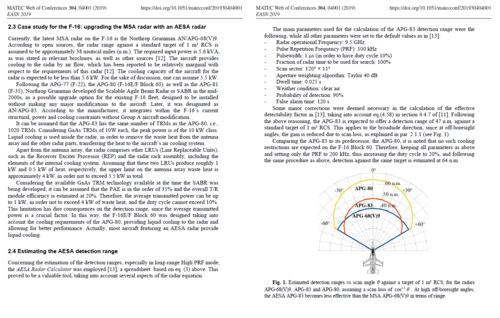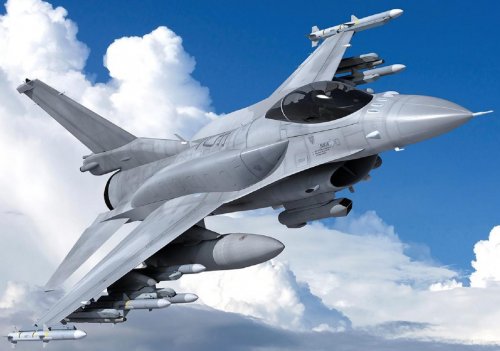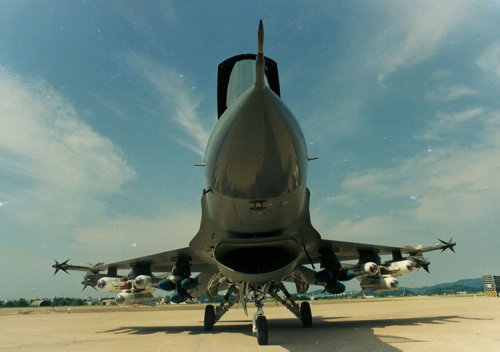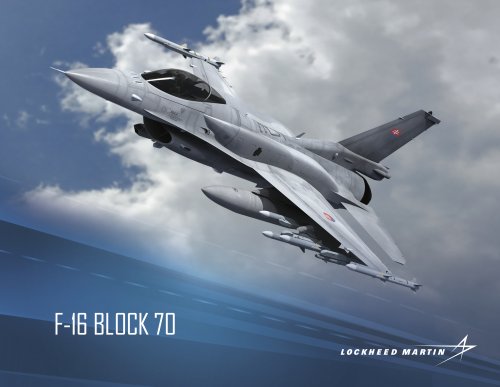Was the F-16IN Super Viper the first time that the name Viper was used in marketing materials?
You are using an out of date browser. It may not display this or other websites correctly.
You should upgrade or use an alternative browser.
You should upgrade or use an alternative browser.
Lockheed Martin F-16 Fighting Falcon Developments
- Thread starter seruriermarshal
- Start date
- Joined
- 3 June 2011
- Messages
- 18,302
- Reaction score
- 12,122
TomS said:(I rthink I might have been at the first open house after the name was assigned -- I certianly remember being at Hill to see the F-16 as a kid).
Are you talking about the first time they invited the public out to see the new plane? I was there too.
V8Interceptor
ACCESS: Restricted
- Joined
- 3 March 2009
- Messages
- 30
- Reaction score
- 3
I've always wondered if; had the official name for the F-16 been simply "Falcon", it would have been accepted and referred to as such by the fighter pilot community.
After all, they had no problem with "Eagle"
Was the "Fighting" suffix added to the name of the aircraft as a way to avoid confusion with the Hughes AIM-4 Falcon series of air-to-air missiles? The -4F/-4G variants of that AAM were still in the ANG inventory during the F-16 procurement;they remained in service with the Guard until 1988 when the last F-106s were retired?
After all, they had no problem with "Eagle"
Was the "Fighting" suffix added to the name of the aircraft as a way to avoid confusion with the Hughes AIM-4 Falcon series of air-to-air missiles? The -4F/-4G variants of that AAM were still in the ANG inventory during the F-16 procurement;they remained in service with the Guard until 1988 when the last F-106s were retired?
Steve Pace
Aviation History Writer
- Joined
- 6 January 2013
- Messages
- 2,266
- Reaction score
- 225
Sounds logical to me. -SPV8Interceptor said:I've always wondered if; had the official name for the F-16 been simply "Falcon", it would have been accepted and referred to as such by the fighter pilot community.
After all, they had no problem with "Eagle"
Was the "Fighting" suffix added to the name of the aircraft as a way to avoid confusion with the Hughes AIM-4 Falcon series of air-to-air missiles? The -4F/-4G variants of that AAM were still in the ANG inventory during the F-16 procurement;they remained in service with the Guard until 1988 when the last F-106s were retired?
- Joined
- 3 June 2011
- Messages
- 18,302
- Reaction score
- 12,122
TomS said:Probably -- my memory is vague. At the time, all I'd seen was X-Wings and TIE fighters (and Vipers).
Was January of '79 and overcast with a bit of rain as I recall.
- Joined
- 3 June 2011
- Messages
- 18,302
- Reaction score
- 12,122
V8Interceptor said:I've always wondered if; had the official name for the F-16 been simply "Falcon", it would have been accepted and referred to as such by the fighter pilot community.
After all, they had no problem with "Eagle"
Was the "Fighting" suffix added to the name of the aircraft as a way to avoid confusion with the Hughes AIM-4 Falcon series of air-to-air missiles? The -4F/-4G variants of that AAM were still in the ANG inventory during the F-16 procurement;they remained in service with the Guard until 1988 when the last F-106s were retired?
I'd heard they couldn't use "Falcon" because Dassault was already using it for a business jet.
- Joined
- 25 June 2009
- Messages
- 14,730
- Reaction score
- 6,068
FighterJock said:Steve Pace said:As I understand it the V suffice simply stands for the name Viper which USAF pilots prefer their '16s to be called. The official name Fighting Falcon never really turned '16 drivers on. -SP
So why did the USAF not call the F-16 the Viper instead of the Fighting Falcon? A highly strange situation if you ask me.
Highly strange? Maybe not. Notice they didn't they rename the A-10 as the Warthog although NO ONE calls it a Thunderbolt II.
There have always been official names and pilot-given names for operational combat types. That doesn't mean the latter should necessarily make it into the official documents. The only case I'm aware of when it actually happened was the F-111, whose later variants received the name Aardvark, a nickname which had been in use for a while with the pilots.
Steve Pace
Aviation History Writer
- Joined
- 6 January 2013
- Messages
- 2,266
- Reaction score
- 225
Then there's the Bone for B-1 (B-one), Boner for B-1R (B-one Regional) bomber - on and on and on...
- Joined
- 16 April 2008
- Messages
- 9,586
- Reaction score
- 14,414
Officially, the F-111 was named Aardvark only at its retirement ceremony; before then there was no official name for the type. Oddly enough, the EF-111 was officially the Raven even while the base model was unnamed.
- Joined
- 3 June 2011
- Messages
- 18,302
- Reaction score
- 12,122
Steve Pace said:Then there's the Bone for B-1 (B-one), Boner for B-1R (B-one Regional) bomber - on and on and on...
http://www.coastcomp.com/av/fltline2/nickname.htm
And many many more. I think the funniest is for the Kaman Husky. "Flying Sh*thouse" ;D
marauder2048
"I should really just relax"
- Joined
- 19 November 2013
- Messages
- 3,157
- Reaction score
- 926
marauder2048 said:LowObservable said:Wouldn't be too sure about that. The F-16 aftermarket is much bigger than any other, and the Korea experience showed how difficult it is to break in.
Willful misrepresentation (and that's a kind way of putting it) makes it difficult to break into just about any market.
More on that willful misrepresentation (I did use that term advisedly)
BAE Spoiled $1.7B Radar Deal With Korea, Suit Says
By Adam Sege
Law360, Wilmington (February 3, 2016, 6:06 PM ET) -- Defense giant Raytheon sued BAE and two subsidiaries in Delaware Chancery Court on Tuesday over the soured $1.7 billion sale of F-16 aircraft radar upgrades to South Korea, saying BAE hid the fact the deal was in trouble and caused its ultimate demise.
While Raytheon Co. had met all its obligations as a subcontractor, prime contractor BAE Systems Holdings Inc. concealed mounting problems with the project and ultimately caused price increases that led to the deal's failure and the subcontractor's losses on the project, the complaint alleges.
“[R]elying on BAE-T’s representations, Raytheon invested millions of its own dollars in the upgrade program,” the suit states. “BAE-T, however, failed to meet its own obligations, both to the U.S. government and to South Korea, and these repeated failures ultimately caused Korea to cancel the purchase.”
The dispute relates to a planned, $1.7 billion sale in which Raytheon and BAE were to provide the South Korean government with radar upgrades for F-16 fighter jets, according to the complaint. After reaching an agreement with the Korean government, the U.S. government designated BAE as the prime contractor on the upgrades, with Raytheon listed as a subcontractor, the suit says.
Raytheon says it assigned 70 employees to the project and abided by all its obligations.
But the sale ultimately fell apart, with the Korean government ending its contract with the U.S., the U.S. government nixing its contract with BAE, and BAE terminating its subcontract with Raytheon.
Raytheon claims that cost increases caused by BAE contributed to the breakdown, and that BAE contributed to Raytheon’s losses by hiding warning signs about the project.
“Despite knowing the upgrade program was in serious trouble, BAE-T continued to tell Raytheon negotiations were on
track and that Raytheon should continue to invest its own funds,” Raytheon says.
The subcontractor’s claims against BAE and its subsidiaries include breach of contract, unjust enrichment, and breach of implied covenant of good faith and fair dealing.
In addition to its immediate losses associated with the botched deal, Raytheon says, the sale’s failure has impacted the subcontractor's future business by robbing it of an opportunity to demonstrate its capability in the F-16 radar market.
“For both companies, winning these contracts represented a beachhead into the large and lucrative F-16 upgrade marketplace, theretofore dominated by Lockheed Martin, the F-16’s original manufacturer, and by Northrop Grumman,
supplier of the F-16’s original radar system,” the suit states.
In a company statement emailed to Law360, BAE said it was "disappointed" to learn its former partner on the project had filed suit.
"As we have said previously, BAE Systems does not believe the company owes the Republic of Korea any monies related to Korea’s decision to cancel the KF-16 upgrade program," BAE continued. "By extension, we do not believe BAE Systems owes Raytheon any additional monies outside of the normal contractual termination settlement process. We are currently reviewing Raytheon’s complaint and will respond in due course through the appropriate legal processes.”
An attorney for Raytheon declined to elaborate on the company’s complaint.
Raytheon is represented by Jack B. Jacobs, Mark D. Hopson, Gordon D. Todd, Maureen B. Soles and Morgan Branch of Sidley Austin LLP.
Counsel information for BAE was not immediately available.
The case is Raytheon Co. v. BAE Systems Holdings Inc. et al., case number 11957, in the Court of Chancery of the State of Delaware.
- Joined
- 9 October 2009
- Messages
- 21,928
- Reaction score
- 13,552

America's Last Fighter Jet Makers Scramble to Keep Production Alive
The end is nearing for the F-15, F-16, and F/A-18 lines unless more orders come in soon.
The company has plans to make structural improvements to the F-16s that remain in military service even after production stops. The company is now pushing what it calls the F-16V, a new configuration that includes some of the technology developed for its successor, the F-35 Joint Strike Fighter.
The upgrades include a new mission computer and Northrop Grumman-made radar, which is common with the same system used on the F-35. That allows the plane to track more targets in the air and on the ground.
The configuration is part of the upgrade the U.S. is offering Taiwan’s existing fleet in lieu of selling new F-16s. Lockheed is also pitching the upgrades to Indonesia. Howard said the company is in discussions “with multiple countries for upgrades of their existing F-16s.”
- Joined
- 3 September 2006
- Messages
- 1,475
- Reaction score
- 1,465
Why would the F-15A be called Rhodan?sferrin said:
I suppose that it is a reference to to scifi books hero Perry Rhodan, but I don't get it.
- Joined
- 16 April 2008
- Messages
- 9,586
- Reaction score
- 14,414
dan_inbox said:Why would the F-15A be called Rhodan?sferrin said:
I suppose that it is a reference to to scifi books hero Perry Rhodan, but I don't get it.
That's a typo. It should be Rodan.

marauder2048
"I should really just relax"
- Joined
- 19 November 2013
- Messages
- 3,157
- Reaction score
- 926
DOD Contracts for Nov. 18, 2016
Lockheed Martin Aeronautics Co., Fort Worth, Texas, has been awarded a $1,204,200,000 fixed-price-incentive-fee contract to upgrade F-16 aircraft for the Republic of Korea. Work will be performed at Fort Worth, Texas, and is expected to be complete by Nov. 15, 2025. This contract is 100 percent foreign military sales to the Republic of Korea. This award is the result of a sole-source acquisition. Air Force Life Cycle Management Center, Wright-Patterson Air Force Base, Ohio, is the contracting activity (FA8615-l 7-C-6045).
Lockheed Martin Aeronautics Co., Fort Worth, Texas, has been awarded a $1,204,200,000 fixed-price-incentive-fee contract to upgrade F-16 aircraft for the Republic of Korea. Work will be performed at Fort Worth, Texas, and is expected to be complete by Nov. 15, 2025. This contract is 100 percent foreign military sales to the Republic of Korea. This award is the result of a sole-source acquisition. Air Force Life Cycle Management Center, Wright-Patterson Air Force Base, Ohio, is the contracting activity (FA8615-l 7-C-6045).
- Joined
- 4 July 2010
- Messages
- 2,510
- Reaction score
- 3,081
5000 seems like an outside shot but possible, 5200 seems pretty unlikely.Archibald said:Will the F-16 beat the 5000th mark, and the Phantom production run ?
Airplane
ACCESS: Secret
- Joined
- 3 October 2015
- Messages
- 433
- Reaction score
- 55
Archibald said:Will the F-16 beat the 5000th mark, and the Phantom production run ?
Amazing if it does. During the Phantom heyday there wasn't much else out there as there is today with the Saab, Rafael, Typhoon. Personally I loved the phantom the first time laid eyes on it, and then I saw it fly a demo... Wow! Wow! Would be nice if the phantom remains undefeated by the 16. A totally modern phantom with engines and avionics and of course missiles would still be a tough cookie today. Still the most beautiful USAF fighter ever (and USMC)
Colonial-Marine
UAVs are now friend, drones are the real enemy.
- Joined
- 5 October 2009
- Messages
- 1,468
- Reaction score
- 1,320
I love the look of the Phantom but I don't know if I'd call it beautiful. Wasn't there a saying about the Phantom only being able to fly because the ground was repulsed by how ugly it was?
Colonial-Marine said:I love the look of the Phantom but I don't know if I'd call it beautiful. Wasn't there a saying about the Phantom only being able to fly because the ground was repulsed by how ugly it was?
That's a funny anecdote.
lantinian
ACCESS: Top Secret
- Joined
- 24 March 2007
- Messages
- 539
- Reaction score
- 174
Re: Lockheed Martin’s Fighting Falcon Evolves With New F-16V
1st, I think we need to merge the "F-16V Takes Flight' topic into this one.
2nd. First time I see an F-16 with a triple AMRAAM launcher and I am impressed although its probably just a rendering and nothing like this exist yet.
Via
https://nationalinterest.org/blog/the-buzz/lockheed-martins-new-f-16-block-70-fighting-falcon-has-f-22-26419
Update: also found this official tweet from LM India, so the 3 launcher is not fan art
https://twitter.com/lmindianews/status/985017881732710400
1st, I think we need to merge the "F-16V Takes Flight' topic into this one.
2nd. First time I see an F-16 with a triple AMRAAM launcher and I am impressed although its probably just a rendering and nothing like this exist yet.
Via
https://nationalinterest.org/blog/the-buzz/lockheed-martins-new-f-16-block-70-fighting-falcon-has-f-22-26419
Update: also found this official tweet from LM India, so the 3 launcher is not fan art
https://twitter.com/lmindianews/status/985017881732710400
Attachments
Re: Lockheed Martin’s Fighting Falcon Evolves With New F-16V
It looks very similar to the launch rack F-16's have for Maverick
lantinian said:2nd. First time I see an F-16 with a triple AMRAAM launcher and I am impressed although its probably just a rendering and nothing like this exist yet.
It looks very similar to the launch rack F-16's have for Maverick
Attachments
lantinian
ACCESS: Top Secret
- Joined
- 24 March 2007
- Messages
- 539
- Reaction score
- 174
Re: Lockheed Martin’s F-16V Block 70/72 Fighting Falcon
Thanks Jemiba. Could you add Block 70/72 to the title of the Thread?
Seams the triple AMRAAM launcher is a standard feature on all Block 70 configurations.
Block 70 For India PDF
https://www.lockheedmartin.com/content/dam/lockheed-martin/aero/documents/F-16/F-16_Block_70_India_Brochure.pdf
Block 70 for Slovakia PDF
https://www.lockheedmartin.com/content/dam/lockheed-martin/aero/documents/F-16/F16%20Product%20Card_Slovakia.pdf
Thanks Jemiba. Could you add Block 70/72 to the title of the Thread?
Seams the triple AMRAAM launcher is a standard feature on all Block 70 configurations.
Block 70 For India PDF
https://www.lockheedmartin.com/content/dam/lockheed-martin/aero/documents/F-16/F-16_Block_70_India_Brochure.pdf
Block 70 for Slovakia PDF
https://www.lockheedmartin.com/content/dam/lockheed-martin/aero/documents/F-16/F16%20Product%20Card_Slovakia.pdf
Attachments
kaiserd
I really should change my personal text
- Joined
- 25 October 2013
- Messages
- 1,657
- Reaction score
- 1,723
MihoshiK said:I see that picture of the Block 70, and all I can think of is how much Pierre Sprey must be frothing at the mouth over it.
How dare an aircraft evolve to better suit what the customer actually wants and actually uses them for....
A fine line between visionaries and zealots, and the former can easily evolve in the latter...
- Joined
- 9 November 2008
- Messages
- 1,070
- Reaction score
- 164
MihoshiK said:Pierre Sprey must be frothing
He started doing that within 5 years of the F-16 going IOC as they added BVR weapons and more sensors to the F-16.
- Joined
- 21 April 2009
- Messages
- 13,732
- Reaction score
- 7,616
- Joined
- 16 April 2008
- Messages
- 9,586
- Reaction score
- 14,414
If they can do that from the air, they can do that from a ship
Kinematics aren't as favorable shooting up from a standing start as they are shooting down from 500 knots.
- Joined
- 11 February 2010
- Messages
- 1,641
- Reaction score
- 2,677
That's a nice "side use" of capability.
For cruise missile scenario tho.. i would put more faith on AMRAAM's.
For cruise missile scenario tho.. i would put more faith on AMRAAM's.
Block 70 has SABR and F-110GE129 while Block 60 has APG-80 and F-110GE 132The Block 70 was a different configuration on offer to India. Then there's the Block 61. The "V" designation is more amorphous and unblock like since, IIRC a customer an do a la carte upgrades from the "V" grab bag of avionics.
GE-132 has higher thrust and block 70 has no cooling upgrade like block 60, so SABR range is much worse than APG-80

- Joined
- 11 February 2010
- Messages
- 1,641
- Reaction score
- 2,677
Aw.. looking at above paper really reminds me that i have to take down the AESA radar calculator and replace it with the fixed version ASAP.
The earlier version i put up have issue namely inconsistent unit, for calculation of detectability factor. I admiteddly made mistake with the equation. The issue was not really obvious as the calculator still does work and give reasonable result, it only came to my awareness after the researcher contacted me and finally i re-read the literatures.
The version used in the paper is rectified version where i finally (hopefully) got things straight with the help of the researcher. The latest version is on the work but i havent released it yet as i incorporated some more features and actually attempt to make a user manual. Containing the equations and "flows" of the sheet.
The earlier version i put up have issue namely inconsistent unit, for calculation of detectability factor. I admiteddly made mistake with the equation. The issue was not really obvious as the calculator still does work and give reasonable result, it only came to my awareness after the researcher contacted me and finally i re-read the literatures.
The version used in the paper is rectified version where i finally (hopefully) got things straight with the help of the researcher. The latest version is on the work but i havent released it yet as i incorporated some more features and actually attempt to make a user manual. Containing the equations and "flows" of the sheet.
- Joined
- 18 May 2019
- Messages
- 640
- Reaction score
- 1,672

This is an abbreviated version of the Aviation Week & Space Technology article “USAF Death Claw Shows New Way To Speed Development”, which describes the full details of issues faced with the F-16’s capabilities, how Death Claw aims to address these issues, and industry insights into the system.
A 40-year-old idea to improve strafing accuracy by transferring flight control of a manned fighter to the autopilot to aim the gun is being revived as the U.S. Air Force looks internally for innovations that can be demonstrated and delivered quickly. An operational version of the Digitally Enhanced Aiming Through Control Law (Death Claw) system is in development less than two years after the U.S. Air Force Test Pilot School conceived and performed an eight-month demonstration.
In effect, Death Claw has two functions. As a new automated flight mode, it solves a practical problem for pilots of F-16s and potentially other fly-by-wire fighters. The system also highlights a path to introducing aircraft upgrades faster by involving the test community up front. Adding an “auto-gunnery mode” to the flight control law, and allow the autopilot control to point the aircraft when the gun is engaged. Bill Gray, chief test pilot of the test pilot school, launched a demonstration program in late 2017 to prove it could work.
The test pilot school owns the F-16 Variable stability Inflight Simulator Test Aircraft (VISTA), an aircraft specially modified to allow inflight changes to the flying qualities. “I realized it would be a relatively simple modification to adjust the control of that airplane to actually test this to do the concept exploration,” he says.
As much as the Air Force pushes to accelerate development, the question still remains how much schedule compression is possible during the test-and-evaluation phase.
In the case of Death Claw, the test pilot school used a live demonstration to prove a basic autopilot capability. Lockheed Martin’s Skunk Works is now working on an improved operational version of the new autopilot gunnery mode, but the Air Force collected the data it needed to make a decision with a rudimentary system created within four months in 2017. The test community also now has experience with the technology, which could help focus the follow-on test schedule.
Death Claw: A New Way To Speed Development? | Aviation Week Network
A 40-year-old idea to improve strafing accuracy by transferring flight control of a manned fighter to the autopilot to aim the gun is being revived as the U.S. Air Force looks internally for innovations that can be demonstrated and delivered quickly.
- Joined
- 9 October 2009
- Messages
- 21,928
- Reaction score
- 13,552

US Air Force wants commoditised F-16 for easier Foreign Military Sales
The US Air Force wants to develop a commoditised Lockheed Martin F-16 to make it easier for US allies and foreign partners to buy the combat aircraft.
Similar threads
-
-
Lockheed Martin F-35 Lightning II Joint Strike Fighter (JSF)
- Started by Triton
- Replies: 6K
-
-
Laser Powers Lockheed Martin’s Stalker UAS For 48 Hours
- Started by seruriermarshal
- Replies: 1
-
Precise F-16 model Royal Australian Air Force markings
- Started by Triton
- Replies: 0



